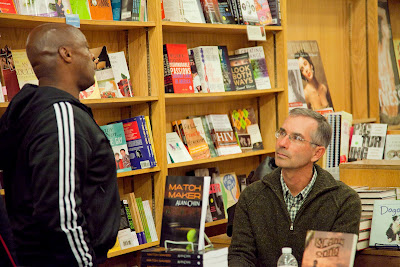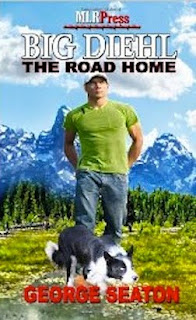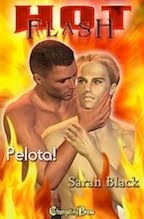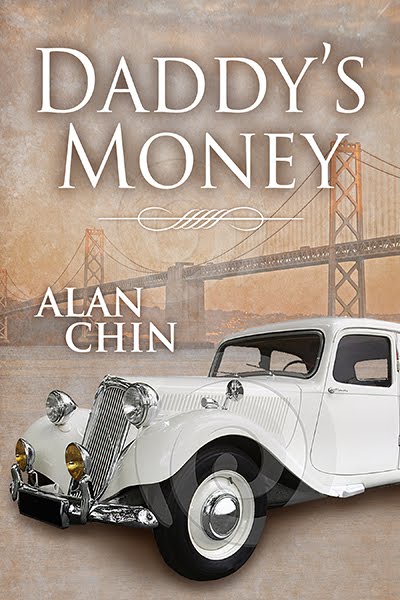It is my pleasure to present the following interview with on of my favorite writers of M/M fiction, Ruth Sims. She has published two novels, Counterpoint: Dylan’s Story and The Phoenix, along with several short stories.
Q: When did you start writing?
RS: If by writing you mean “making up stories” I think I was doing that when I came out of the womb. Rather shocked my mother! If you mean “putting words on paper” I was six or seven, seven I believe, when I wrote my first novel. It was probably all of three pages long and it opened with the immortal lines “It was spring. There was a horse.” I ask you, how could the Pulitzer and Nobel people have turned down such a story? But they did.
Q: Was there someone in your family, a teacher, or perhaps a favorite book, that inspired you to begin writing?
RS: I can, without hesitation, name my first grade teacher, Miss Swisher. She was, as they said in the olden days when I was young, an “old maid,” or the more polite folks said she was a “spinster.” I was painfully shy and out of place. I could read before I went to school so whenever my classmates were studying See Spot. See Spot run, she arranged for me to go to the school library and help. My fondest smell is that of library paste and books. I was also poor, from a large family. We had no car. My teacher, for years after I left her class, took me to the city library, and to the park on the first day of spring to look for wildflowers. When I was bored with the simple books in the children’s part of the library she lent me books from her own library, so I was reading years ahead of my grades. Sometimes I spent Sunday with her and her family. I even had her sister as a teacher in high school. I owe my mother sincere thanks for many things, most of all for allowing Miss Swisher to “adopt” me, as it were, and give me learning advantages my mother couldn’t.
Q: Who are the authors who most influence you?
RS: Jack London, Stephen Vincent Benét, Edgar Allen Poe, Thomas Hardy, Gene Stratton Porter. More recently, Patricia Nell Warren, Mary Renault, and Pat Barker. I think of them all, Benét’s “John Brown’s Body” had the most long-lasting effect. What an amazing book: the American Civil War told in verse, with a different narrative voice for every character, both real and fictional, black and white, and both sides of the conflict! I loved (still do) the old story poems, like “The Highwayman” and “Rime of the Ancient Mariner” and “The Hired Man.”
Q: Your debut novel, The Phoenix had two wonderful characters. What was the inspiration behind Kit and Nick?
RS: I was afraid you’d ask me that, because I don’t know. Well, that’s only half true. Nick was always in it, and through all the years and all the variations, he didn’t really change, except that he finally convinced me he was gay. He was always solid, earnest, serious, with more than a small streak of the Puritan in him. Kit, however, was originally just a bit player. Can you even imagine Kit accepting a “spear-carrier” role? Obviously, he wasn’t happy. And gradually and irresistibly he took over the story. Oh, and one other small thing changed. It went from being an American Civil War story (heterosexual, yet) to being a Victorian gay love story. Go figure. I have a blog article about that called “How To Turn a Straight Civil War Story Into a Gay Victorian Romance In Just Twenty Years.” Anybody who wants it, may email me at ruth.sims@gmail.com. It’s free.
Q: Counterpoint Dylan’s Story, has garnered several excellent reviews, including my own. Can you tell us about the story?
RS: Counterpoint: Dylan’s Story is about passion. Not sexual passion, though there is that too in the course of time and relationship, but the passion to create. Dylan is a young man who knows he was born to compose new music for a new century, and it is the consuming passion of his life. It’s about the passion to believe in yourself and your dream and be willing to fight both God and the devil for it. It’s about the love of one man for another even if it means living together in exile. It’s about the gentle passion of friendship and believing in someone else. It’s also about a loss so devastating a dream dies, and it’s about the reawakening of that dream. Most of all it’s about people.
I dearly love this story and the people in it, and I think it’s the best thing I have ever written. To my delight, it has been nominated for the 2011 ALA Stonewall Award.
Q: I understand it took several years to bring Counterpoint Dylan’s Story to print. Can you tell us why it took so long?
RS: I started it in the mid-80’s! I can’t go into too much detail without making this a major spoiler, but I can say that I listened to the insistent advice of someone who told me no one would publish it unless I eliminated one key event that occurs halfway through the story. Unlike Dylan, I didn’t have enough confidence in my own work, and I believed to her. As a result I spent several years rewriting the story from start to finish, over and over, trying to make the event in question “go away.” In fairness to my questionable advisor, I should say that I, too, wished the event would go away. Finally, two Australian friends read both the old and the new versions, and said, in effect, “Enough already! Go back to the original! This last one is okay, but the original is a thousand times better.” I listened. Less than a year later it was finished, except for minor tweaking. Less than a month after submitting it to Dreamspinner, I had a contract. Less than four months after submitting it, I had a book.
Q: If you don’t mind sharing, would you tell us about your latest work in progress?
RS: I have a half dozen, and none of them are close to completion, but I’ll restrain myself and mention just two: Whom God Destroys is a very unromantic, dark story of an Edwardian serial killer in London who makes Jack the Ripper seem like a choirboy. The psychotic protagonist is also a slight, pretty, very accomplished female impersonator with an outsize ego. Hannibal without the cannibalism?
Mahrime (mah-ri-may): Forbidden is a story of two young Rom (Gypsy) men in England. It’s a love story, but also tackles the class prejudices and anti-Gypsy laws and attitudes. It’s giving me a chance to use the mountains of research I unearthed when I was writing about Geoffrey in Counterpoint.
Q: You’ve written two historical novels, both in a similar time and place. What is it about 19th century England that captures your imagination?
RS: I think the main appeal is that it’s close enough to us in time that it feels almost contemporary but it’s far enough in the past that I don’t have to deal with my characters having cell phones and Twitter accounts. I do have one w.i.p. set in America in 1910-1930 era, and one contemporary (Rain Dancer), which is my second crime story. As for “why England” I guess because it’s both familiar and exotic to a Midwesterner, and I’ve always loved English authors, movies, and humor.
Q: Both your novels are rather emotional. What’s the secret of writing a gripping drama?
RS: Well, I’m no expert; I didn’t go to college so I haven’t studied any of it to know what the proper way is, but I can tell you how I do it. When I draft I put in everything. When I revise I take out most of it. It’s like making maple syrup. They tap the trees to get the clear sap and then boil it and boil it and distill it until they have the wonderfulm golden brown food of the gods.
It’s alarmingly easy to slip from drama into eye-rolling melodrama. In a draft, that’s just fine. But in the revisions, even though a character may be inwardly flailing about with some great soul pain or tragedy, I pare the outward actions to small, homely acts that are universal. A word, a clenched jaw, a gesture such as closing the eyes of a dead beloved brings everything home to the reader. I really think when it comes to portraying emotion, the old saying “less is more” is very appropriate. Restrained, taut writing involves a reader but purple prose is annoying and, unfortunately, sometimes makes a reader laugh in all the wrong places. I believe that reading everything aloud (in private of course) is the biggest help of all. Your ear might catch what your eye misses.
Q: You have written several short stories. One I read, The Lawyer, The Ghost, and The Cursed Chair, was delightful. Do you have a preference for writing short fiction vs. novels?
RS: I love short stories. I’ve always said I wasn’t very good at them, but Jay Hartman has convinced me otherwise, and has published four of them so far. My first favorite authors were the short story masters. They knew just what to put in and what to leave out. “The Lawyer, The Ghost, and the Cursed Chair” is one of my pets. It used to be much shorter, but every time I read it to a group of people another piece of business would occur to me, and since it was “never going to be published anyway” I kept adding to it (thus breaking my own rules)! My most recent one, “Song on the Sand,” I think may be the best thing I’ve done second only to Counterpoint. I believe Jay is going to enter two of them, “Song on the Sand” and “Burma Girl,” in the competition for the prestigious Pushcart Prize.
Q: If you could offer one tidbit of advice for new writers, what would it be?
RS: I’m repeating myself here… Read aloud. Read with all the feeling your characters are feeling. Laugh. Shout. Cry. Threaten. Cuss. Yell obscenities. Joke. Baby talk. Whatever your words say. Just make sure you’re not in a crowded restaurant or walking down the street or sitting in a car beside a patrol car with the windows down while you’re doing it!
Q: What do you like to do when you’re not writing?
RS: I’d like to say that when I’m not writing I’m hang-gliding or getting full-body tattoos or roaring cross-country on my Harley, but when all is said and done, I’m just a little old lady from the Midwest. I like to be with my family, go to local amateur theatre productions, listen to classical and Romantic music, pet my old cat or my older husband, whichever is closest. I like to read, bake (especially bread; it’s not as beautiful as what my mother used to make but it smells like heaven). I also love to watch old movies, in particular silents, which I’ve come to love via Turner Classic Movies. I love sending and getting email from readers and friends. And I enjoy talking, sometimes about shamefully trivial things. And ok, I’ll admit it, I like funny, dirty limericks.
Q: Had you not become an accomplished writer, what other occupation would you have most liked to tackle?
RS: Accomplished? I certainly have you fooled! The truth is, I’m just a self-taught storyteller and a very slow one, at that. Like Dylan and his music, I’ve only ever wanted to do one thing. Maybe I’d like to teach school—but only if I could do it my way, without all the bureaucratic crap teachers have to deal with. Or maybe I’d be a good psychotherapist. No chance of being a world-class surgeon because I can’t stand the sight of blood and icky things, not to mention I’m klutzy.
Q: Do you enjoy writing, I mean, do you find it fun?
RS: The initial drafting is work. Research is fun. Revising is (usually) fun because then I can play with the words, it’s like a game. The many years I spent trying to alter the course of Counterpoint were closer to agony than fun. But for the most part, yes, it’s fun. Of course the “funnest” part of writing is getting to know other writers and the wonderful readers who have written to me. Many of them have become good friends.
Q: What, more than anything else, fills you with rage?
RS: Unfairness, injustice, and cruelty committed in the name of religion. I don’t care whether it’s Christianity, Islam, or what. It’s wrong to use the mantra “God says” or “Allah says” to justify meanness and hatred. That’s all I should say because if I say more I’ll get on a soap box. I would just like to add that I’m not speaking as an outsider. I am a preacher’s granddaughter. I grew up immersed to my eyeballs in religion.
Q: Can you tell us something about the place you call home?
RS: The house and the town are both small-town working-class Mid-America, straight out of Norman Rockwell, and the only town I’ve ever lived in. We bought our house ten years ago partly because it has a floor-to-ceiling bay window that looks out upon hickory trees, and a backyard with a half acre of assorted trees that we call the woods. We have a parade of critters – mostly whitetails that stand around outside the garage door waiting for corn in the winter, a red fox, woodchucks, wild turkeys, the obligatory squirrels and chipmunks, cardinals, woodpeckers, hummingbirds and various other feathered and furred beings. I love toads and am always happy when we find a toad or a turtle. The house is comfortably cluttered (to me) and horribly messy (to my husband, aka “Mr. Clean-on-Steroids”). I expect it’s somewhere in between. The appliances are almost forty years old but still working, and as long as they work, that’s good enough for me.
Q: Where can readers find more of your work?
RS: Everything that has been published is, of course, available on Amazon, and also through the publishers’ websites. I know everybody knows where Amazon is, but here are the publishers’ sites:
The Phoenix -- Lethe Press 2009 http://lethepressbooks.com/gay.htm#sims-the-phoenix – scroll down; you’ll find it
Counterpoint: Dylan’s Story – Dreamspinner Press 2010 -- http://www.dreamspinnerpress.com/store/
My four short story e-books are at http://store.untreedreads.com – search by my name or the title:
The Lawyer, the Ghost, and the Cursed Chair
Mr. Newby’s Revenge
Burma Girl
Song on the Sand
And there are two FREEBIES:
“Tom, or an Improbable Tail” at http://allromanceebooks.com/product-tomoranimprobabletail-14965-180.html
And “Mariel” at http://www.blithe.com/ (Blithe House Quarterly)
I also have a short story “Legend of the Mountain Ash” in the charity anthology I Do Two. All proceeds go to Lambda Legal to help with the fight for marriage equality.
Q: Anything else you’d like to share?
RS: I always like to end an interview with this plea to readers:
When you read something that moves you, or makes you laugh or cry, or widens your world or…well, really, anything you simply enjoy, please let the author know! Not just me (though I treasure every letter from a reader) but my fellow fiction authors, too. We are crazy people involved in a lonely and crazy profession. We spend time alone with people who don’t exist in the real world. We talk to them and they are real to us. In my case, I nurture them for years! Then we send them out into the world… and unless we hear from readers we feel like we’ve sent them out into a cold, uncaring void. Not even your mother will appreciate your words quite as much as a lonely writer, pecking away on a keyboard somewhere.
Thank you, Ruth, for sharing with us. All the best with your new release.























.jpg)